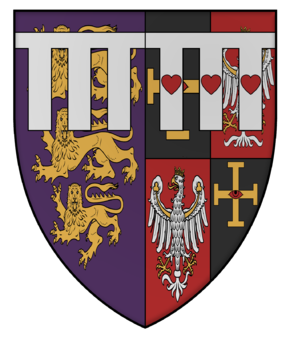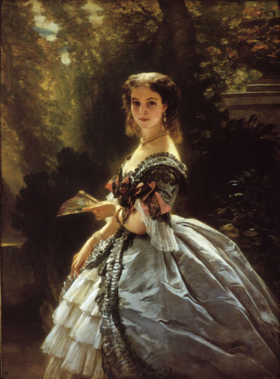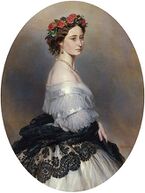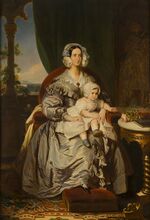Difference between revisions of "Elizabeth, Princess Imperial"
| Line 57: | Line 57: | ||
'''Princess Elizabeth Anne''' was born within the Imperial capital of Helena upon Saint Julia’s Day, the 17th of Malins Welcome 1755, to the Princess Imperial [[Anne I, Holy Orenian Empress|Anne Augusta]] and her husband the Duke of Helena, [[Joseph II, Holy Orenian Emperor|Joseph Sarkozy]]. At the time, the empire was still under the reign of her grandfather, [[Peter III, Holy Orenian Emperor|Peter III]]. Her birth marked the foundation of the Imperial house of [[Novellen]] and as such was a widely celebrated event. | '''Princess Elizabeth Anne''' was born within the Imperial capital of Helena upon Saint Julia’s Day, the 17th of Malins Welcome 1755, to the Princess Imperial [[Anne I, Holy Orenian Empress|Anne Augusta]] and her husband the Duke of Helena, [[Joseph II, Holy Orenian Emperor|Joseph Sarkozy]]. At the time, the empire was still under the reign of her grandfather, [[Peter III, Holy Orenian Emperor|Peter III]]. Her birth marked the foundation of the Imperial house of [[Novellen]] and as such was a widely celebrated event. | ||
| − | The Princess spent her formative years within the Novellen palace, being afforded a rich education by numerous of the most | + | The Princess spent her formative years within the Novellen palace, being afforded a rich education by numerous of the most skilled scholars within Oren. As the firstborn to the Princess Imperial and the Duke of Helena, Elizabeth was often doted on and adored by those at court, being known as the favoured child amongst the Imperial family. Much of her education was under the renowned Archchancellor [[Simon Basrid]], a man who instilled imperial values within her that would dictate the course of her life. |
[[File:elizabethdebutante.jpg|thumb|right|145px|''The Debutante, Princess Elizabeth, c. 1771]] | [[File:elizabethdebutante.jpg|thumb|right|145px|''The Debutante, Princess Elizabeth, c. 1771]] | ||
| − | Elizabeth’s learning was centred around tales of history, as well as fables of Rhenyari mythology | + | Elizabeth’s learning was centred around tales of history, as well as fables of Rhenyari mythology - being the core of her education. She had a strong passion for writing in which was echoed in her upbringing, and wrote her first published work at the age of fourteen, titled: “OF PROVIDENCE: A Mentor to the Future”. |
<blockquote>''“Providence, you see, is the eye of wisdom; the eye of God himself. In Providence we inspire liberty and justice, innovation and progress. You cannot ‘reach’ providence, for it is an idea. It is the guiding light to move us from one place to the next… Providence tells us one thing, among many: to innovate what was set before us.” -OF PROVIDENCE: A Mentor to the Future, 1770''</blockquote> | <blockquote>''“Providence, you see, is the eye of wisdom; the eye of God himself. In Providence we inspire liberty and justice, innovation and progress. You cannot ‘reach’ providence, for it is an idea. It is the guiding light to move us from one place to the next… Providence tells us one thing, among many: to innovate what was set before us.” -OF PROVIDENCE: A Mentor to the Future, 1770''</blockquote> | ||
| Line 70: | Line 70: | ||
Upon her sixteenth birthday the Princess was presented in the form of a Debutante ball in her honour, introducing the girl to the wider Imperial society as a woman, no longer a child. Many attended her birthday celebrations, centralised around the core theme of her character and passions: History. Each attendee wore a costume of a ‘figure who shaped the empire’, to which she awarded prizes for her favourite. Elizabeth, particularly, wore a costume fashioned after her own grandfather’s formalwear - Peter III. | Upon her sixteenth birthday the Princess was presented in the form of a Debutante ball in her honour, introducing the girl to the wider Imperial society as a woman, no longer a child. Many attended her birthday celebrations, centralised around the core theme of her character and passions: History. Each attendee wore a costume of a ‘figure who shaped the empire’, to which she awarded prizes for her favourite. Elizabeth, particularly, wore a costume fashioned after her own grandfather’s formalwear - Peter III. | ||
| − | The | + | The event signified the Princess' entry into the potential market for marriage, and as such attracted eligible suitors to vie for her hand. She paid notable attention to the County of Pomourelia's heir, Peter Amadeus - with the teenage girl becoming undoubtedly smitten. However, Peter was murdered at the hands of Sutican officials before any formal sense of courtship could be established. His death caused significant grief within a sixteen year old Elizabeth, and is considered to be a sustaining reason as to why she refused to wed for another fifteen years. |
===Tenure within the Imperial State Army=== | ===Tenure within the Imperial State Army=== | ||
| − | Shortly before her seventeenth birthday, Elizabeth | + | Shortly before her seventeenth birthday, Princess Elizabeth expressed her intent to join the Imperial State Army, particularly that of the Medical Corps. With no prior Orenian princess having enlisted in the Army, her parents expressed considerable doubt - particularly that of her Father Joseph II, who held strong reservations against the girl's participation in the military, particularly within combat. After encouragement and discussion from the Archchancellor in 1767, Elizabeth's parents agreed to allow her to enlist. |
| − | + | She began her formal induction as a cadet shortly after, and received comprehensive medical training under the Viscount of Pruvia-Provins, John Michael. Her first years in the Army are considered to have been an incredibly happy time for the Princess, who dedicated much of her time and efforts into furthering the ISA Medical Corps. Elizabeth and John Pruvia worked very closely together, and the pair began to develop a relationship that many believed to be the beginning of a courtship. However, this proved disastrous, and only further swayed the princess away from the potential of marriage. | |
Shortly after turning nineteen, Elizabeth graduated from the ISA Combat Academy, moving to the Officer rank of Ensign. It was there that she served the Medical Corps for a period of several years, up until the later birth of her children that shifted her priorities from the ISA. | Shortly after turning nineteen, Elizabeth graduated from the ISA Combat Academy, moving to the Officer rank of Ensign. It was there that she served the Medical Corps for a period of several years, up until the later birth of her children that shifted her priorities from the ISA. | ||
| Line 82: | Line 82: | ||
== Marriage == | == Marriage == | ||
| − | Following the tragic death of Peter Amadeus and a brief and ultimately disastrous courtship with Ensign John Pruvia, Elizabeth petitioned her Father for the ability to remain unwed. The Duke of Helena did honour her request, however encouraged | + | Following the tragic death of Peter Amadeus and a brief and ultimately disastrous courtship with Ensign John Pruvia, Elizabeth petitioned her Father for the ability to remain unwed. Citing her wishes to serve the Empire - and the Empire only, she argued that marriage was a distraction from her service to state. The Duke of Helena did honour her request in allowing the princess to remain unwed, however encouraged Elizabeth to carefully consider her decision over the coming years. |
| − | It was ultimately on the advice of her mentor Simon Basrid in which the Princess again considered marriage. | + | It was ultimately on the advice of her childhood mentor Simon Basrid in which the Princess again considered marriage in early 1780. Basrid promptly urged her toward her childhood companion and State Army comrade Iskander Basrid, being his own grand-nephew and the heir to the County of Susa. After an extended courtship, given Elizabeth's reluctance to wed, Elizabeth eventually agreed to the marriage in 1784. A formal petition was placed before Emperor Peter III, the Duke of Helena, and the Princess Imperial in 1785. This was accepted, on the terms of a morganatic marriage - meaning that Elizabeth's children would not hold a place in the Imperial line of succession. |
The pair wed in 1786, siring four children - Jasper Clement, Anthony Alexios, Helena Augusta and Nicholas Andreas. | The pair wed in 1786, siring four children - Jasper Clement, Anthony Alexios, Helena Augusta and Nicholas Andreas. | ||
| Line 116: | Line 116: | ||
| [[Jasper Clement Basrid]] || 8th of the Sun's Smile, 1787 || Alive || Missing || Firstborn child of Elizabeth and Iskander. Left the Empire for the lands of Ba'as in his early years. | | [[Jasper Clement Basrid]] || 8th of the Sun's Smile, 1787 || Alive || Missing || Firstborn child of Elizabeth and Iskander. Left the Empire for the lands of Ba'as in his early years. | ||
|- | |- | ||
| − | | [[Anthony Alexios Basrid]] || 1st of Godfrey's Triumph, 1788|| Alive || Valeria Ruthern || Secondborn child of Elizabeth and Iskander. Heir to the County of Susa | + | | [[Anthony Alexios Basrid]] || 1st of Godfrey's Triumph, 1788 || Alive || Valeria Ruthern || Secondborn child of Elizabeth and Iskander. Heir to the County of Susa |
|- | |- | ||
| − | | [[Helena Augusta Basrid]] || 12th of Harrens Folly, 1791 || Alive || Unwed || Thirdborn child of Elizabeth and Iskander | + | | [[Helena Augusta Basrid]] || 12th of Harrens Folly, 1791 || Alive || Unwed || Thirdborn child and only daughter of Elizabeth and Iskander |
|- | |- | ||
| [[Nicholas Andreas Basrid]] || 2nd of Horen's Welcome, 1792 || 1744 || Unwed || Fourthborn child of Elizabeth and Iskander | | [[Nicholas Andreas Basrid]] || 2nd of Horen's Welcome, 1792 || 1744 || Unwed || Fourthborn child of Elizabeth and Iskander | ||
Revision as of 15:38, 8 February 2021
|
| ||||||||||||||||||
Elizabeth, Princess Imperial (High Imperial: Elisabeth Anna), otherwise monikered as Elizabeth of Helena, was an Imperial Princess as daughter to Anne I, Holy Orenian Empress, and her husband and co-ruler Joseph II, Holy Orenian Emperor. Upon her Mother and Father’s ascension to the throne in 1784, she inherited the title of ‘Princess Imperial’, formerly her Mother’s own. Additionally, the Princess was afforded her own peerage in 1787 as the Countess of Rosemoor.
She wed the Count of Susa, Iskander Basrid, and their union produced three sons and one daughter.
Contents
Biography
Early life
Princess Elizabeth Anne was born within the Imperial capital of Helena upon Saint Julia’s Day, the 17th of Malins Welcome 1755, to the Princess Imperial Anne Augusta and her husband the Duke of Helena, Joseph Sarkozy. At the time, the empire was still under the reign of her grandfather, Peter III. Her birth marked the foundation of the Imperial house of Novellen and as such was a widely celebrated event.
The Princess spent her formative years within the Novellen palace, being afforded a rich education by numerous of the most skilled scholars within Oren. As the firstborn to the Princess Imperial and the Duke of Helena, Elizabeth was often doted on and adored by those at court, being known as the favoured child amongst the Imperial family. Much of her education was under the renowned Archchancellor Simon Basrid, a man who instilled imperial values within her that would dictate the course of her life.
Elizabeth’s learning was centred around tales of history, as well as fables of Rhenyari mythology - being the core of her education. She had a strong passion for writing in which was echoed in her upbringing, and wrote her first published work at the age of fourteen, titled: “OF PROVIDENCE: A Mentor to the Future”.
“Providence, you see, is the eye of wisdom; the eye of God himself. In Providence we inspire liberty and justice, innovation and progress. You cannot ‘reach’ providence, for it is an idea. It is the guiding light to move us from one place to the next… Providence tells us one thing, among many: to innovate what was set before us.” -OF PROVIDENCE: A Mentor to the Future, 1770
Debut into Society
“She is my firstborn child. . The first time I ever held her, I felt that she embodied the progress of our Empire, the hopes we as Humanity shared as the Troubles fell into twilight. Late into every night, I would stay awake by her little crib, and make sure she was still safe and slumbering. My most treasured moments, as a mother, was to hold her in my arms as she fell asleep. Elizabeth Anne was always quiet- always gentle, and she has always been kind. To watch her grow into the young lady she is now has been a blessing, and I know she will continue to do great things- wonderful things, and I could not be more proud of her.” -Anne Augusta’s speech at Elizabeth Anne’s Debutante Ball, 1772
Upon her sixteenth birthday the Princess was presented in the form of a Debutante ball in her honour, introducing the girl to the wider Imperial society as a woman, no longer a child. Many attended her birthday celebrations, centralised around the core theme of her character and passions: History. Each attendee wore a costume of a ‘figure who shaped the empire’, to which she awarded prizes for her favourite. Elizabeth, particularly, wore a costume fashioned after her own grandfather’s formalwear - Peter III.
The event signified the Princess' entry into the potential market for marriage, and as such attracted eligible suitors to vie for her hand. She paid notable attention to the County of Pomourelia's heir, Peter Amadeus - with the teenage girl becoming undoubtedly smitten. However, Peter was murdered at the hands of Sutican officials before any formal sense of courtship could be established. His death caused significant grief within a sixteen year old Elizabeth, and is considered to be a sustaining reason as to why she refused to wed for another fifteen years.
Tenure within the Imperial State Army
Shortly before her seventeenth birthday, Princess Elizabeth expressed her intent to join the Imperial State Army, particularly that of the Medical Corps. With no prior Orenian princess having enlisted in the Army, her parents expressed considerable doubt - particularly that of her Father Joseph II, who held strong reservations against the girl's participation in the military, particularly within combat. After encouragement and discussion from the Archchancellor in 1767, Elizabeth's parents agreed to allow her to enlist.
She began her formal induction as a cadet shortly after, and received comprehensive medical training under the Viscount of Pruvia-Provins, John Michael. Her first years in the Army are considered to have been an incredibly happy time for the Princess, who dedicated much of her time and efforts into furthering the ISA Medical Corps. Elizabeth and John Pruvia worked very closely together, and the pair began to develop a relationship that many believed to be the beginning of a courtship. However, this proved disastrous, and only further swayed the princess away from the potential of marriage.
Shortly after turning nineteen, Elizabeth graduated from the ISA Combat Academy, moving to the Officer rank of Ensign. It was there that she served the Medical Corps for a period of several years, up until the later birth of her children that shifted her priorities from the ISA.
Marriage
Following the tragic death of Peter Amadeus and a brief and ultimately disastrous courtship with Ensign John Pruvia, Elizabeth petitioned her Father for the ability to remain unwed. Citing her wishes to serve the Empire - and the Empire only, she argued that marriage was a distraction from her service to state. The Duke of Helena did honour her request in allowing the princess to remain unwed, however encouraged Elizabeth to carefully consider her decision over the coming years.
It was ultimately on the advice of her childhood mentor Simon Basrid in which the Princess again considered marriage in early 1780. Basrid promptly urged her toward her childhood companion and State Army comrade Iskander Basrid, being his own grand-nephew and the heir to the County of Susa. After an extended courtship, given Elizabeth's reluctance to wed, Elizabeth eventually agreed to the marriage in 1784. A formal petition was placed before Emperor Peter III, the Duke of Helena, and the Princess Imperial in 1785. This was accepted, on the terms of a morganatic marriage - meaning that Elizabeth's children would not hold a place in the Imperial line of succession.
The pair wed in 1786, siring four children - Jasper Clement, Anthony Alexios, Helena Augusta and Nicholas Andreas.
As Princess Imperial
The Princess remained devoutly engaged with the Imperial court following her Mother and Father's ascension on the 14th of Sun’s Smile, 1784. She inherited her Mother's previous title of 'Princess Imperial', as well as being granted the additional honour of Imperial Peerage as the Countess of Rosemoor.
Elizabeth served as Majordomo of the palace during this period, as well as launching the Imperial State University. TBA
Titles, Styles, and Honors
Titles and Styles
- 1755-1784 Her Imperial Highness, Princess Elizabeth of Helena
- 1784-1786 Her Imperial Highness, the Princess Imperial
- 1787-1805 Her Imperial Highness, the Princess Imperial, 1st Countess of Rosemoor
- 1805-present Her Imperial Highness, the Princess Imperial, 1st Countess of Rosemoor, Countess of Susa
Armorial Bearings

The Princess Imperial's arms were granted and confirmed in 1795 by the Imperial King of Arms, Robert James Hartcold. Elizabeth's personal arms (First and fourth sable, on a cross potent or a eye gules, second and third gules an eagle argent crowned, armed and beaked or, the wings charged with trefoils or. Overall a label of three points argent each charged with a heart gules) were impaled with those of her husband, Iskander Basrid, (Purpure three lions passant guardant Or overall a label of three points Argent) following her marriage to him in 1786.
Issue
| Name | Birth | Death | Marriage | |
|---|---|---|---|---|
| Jasper Clement Basrid | 8th of the Sun's Smile, 1787 | Alive | Missing | Firstborn child of Elizabeth and Iskander. Left the Empire for the lands of Ba'as in his early years. |
| Anthony Alexios Basrid | 1st of Godfrey's Triumph, 1788 | Alive | Valeria Ruthern | Secondborn child of Elizabeth and Iskander. Heir to the County of Susa |
| Helena Augusta Basrid | 12th of Harrens Folly, 1791 | Alive | Unwed | Thirdborn child and only daughter of Elizabeth and Iskander |
| Nicholas Andreas Basrid | 2nd of Horen's Welcome, 1792 | 1744 | Unwed | Fourthborn child of Elizabeth and Iskander |
Ancestors
| Ancestors of Elizabeth, Princess Imperial | ||||||||||||||||||||||||||||||||||||||||||||||||||||||||||||||||||||||||||||||||||||||||||||||||||||||||||||||||||||||||||||||||||||||||||||||||||||||||||||||||||||||||||||||||||||||||||||||||||||||||||||||||||||||||||||||||||||||||||||||||||||||||||||||||||||||||||||||||||||||||||||||||||||||||||||||||||||||||||||||||||||||||||||||||||||||||||||||||||||||||||||||||||||||||||||||||||||||||||||||||||||||||||||||||||||||||||||||||||||||||||||||||||||||||||||||||||||||||||||||||||||||||||||||||||||||||||||||||||
|---|---|---|---|---|---|---|---|---|---|---|---|---|---|---|---|---|---|---|---|---|---|---|---|---|---|---|---|---|---|---|---|---|---|---|---|---|---|---|---|---|---|---|---|---|---|---|---|---|---|---|---|---|---|---|---|---|---|---|---|---|---|---|---|---|---|---|---|---|---|---|---|---|---|---|---|---|---|---|---|---|---|---|---|---|---|---|---|---|---|---|---|---|---|---|---|---|---|---|---|---|---|---|---|---|---|---|---|---|---|---|---|---|---|---|---|---|---|---|---|---|---|---|---|---|---|---|---|---|---|---|---|---|---|---|---|---|---|---|---|---|---|---|---|---|---|---|---|---|---|---|---|---|---|---|---|---|---|---|---|---|---|---|---|---|---|---|---|---|---|---|---|---|---|---|---|---|---|---|---|---|---|---|---|---|---|---|---|---|---|---|---|---|---|---|---|---|---|---|---|---|---|---|---|---|---|---|---|---|---|---|---|---|---|---|---|---|---|---|---|---|---|---|---|---|---|---|---|---|---|---|---|---|---|---|---|---|---|---|---|---|---|---|---|---|---|---|---|---|---|---|---|---|---|---|---|---|---|---|---|---|---|---|---|---|---|---|---|---|---|---|---|---|---|---|---|---|---|---|---|---|---|---|---|---|---|---|---|---|---|---|---|---|---|---|---|---|---|---|---|---|---|---|---|---|---|---|---|---|---|---|---|---|---|---|---|---|---|---|---|---|---|---|---|---|---|---|---|---|---|---|---|---|---|---|---|---|---|---|---|---|---|---|---|---|---|---|---|---|---|---|---|---|---|---|---|---|---|---|---|---|---|---|---|---|---|---|---|---|---|---|---|---|---|---|---|---|---|---|---|---|---|---|---|---|---|---|---|---|---|---|---|---|---|---|---|---|---|---|---|---|---|---|---|---|---|---|---|---|---|---|---|---|---|---|---|---|---|---|---|---|---|---|---|---|---|---|---|---|---|---|---|---|---|---|---|---|---|---|---|---|---|---|---|---|---|---|---|---|---|---|---|---|---|---|---|---|---|---|---|---|---|---|---|---|---|---|---|---|---|---|---|---|---|---|---|---|---|---|---|---|---|---|---|---|---|---|---|---|---|---|---|---|---|---|---|---|---|---|---|---|---|---|---|---|---|---|---|---|---|---|---|---|---|---|
|
|
||||||||||||||||||||||||||||||||||||||||||||||||||||||||||||||||||||||||||||||||||||||||||||||||||||||||||||||||||||||||||||||||||||||||||||||||||||||||||||||||||||||||||||||||||||||||||||||||||||||||||||||||||||||||||||||||||||||||||||||||||||||||||||||||||||||||||||||||||||||||||||||||||||||||||||||||||||||||||||||||||||||||||||||||||||||||||||||||||||||||||||||||||||||||||||||||||||||||||||||||||||||||||||||||||||||||||||||||||||||||||||||||||||||||||||||||||||||||||||||||||||||||||||||||||||||||||||||||||



